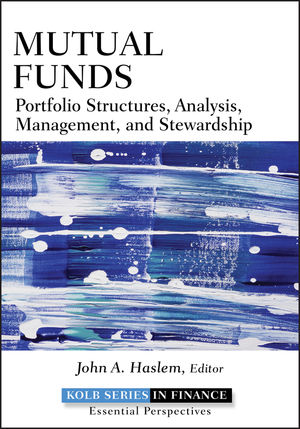Mutual Funds: Portfolio Structures, Analysis, Management, and StewardshipISBN: 978-0-470-49909-2
Hardcover
358 pages
November 2009
 This is a Print-on-Demand title. It will be printed specifically to fill your order. Please allow an additional 10-15 days delivery time. The book is not returnable.
|
||||||
I. Mutual Funds: Nature, Regulation, and Costs.
Chapter One: The Nature of Mutual Funds by (Conrad Ciccotello).
Attributes of the Open-End Mutual Fund.
The Board of Directors.
Liquidity.
All Equity Capital Structure.
Portfolio Diversification.
Professional Management.
Investor Services.
Mutual Funds and the Competitive Environment.
Employer Sponsored Retirement Plans.
After-Tax Accounts.
References.
About The Author.
Chapter Two: Mutual Fund Regulation and Issues by (Conrad Ciccotello).
Historical Perspective.
Regulation of Open-End Funds.
Recent Regulatory Issues in Open-End Funds.
NAV Pricing and Trading Policies.
Fund Pricing and the (Late) Trading Scandal.
Current Regulatory Issues in Funds.
Board Governance.
Fees.
Performance Reporting.
References.
About The Author.
Chapter Three: The Economics of Mutual Funds by (David M. Smith).
Size and structure of the mutual fund industry.
Mutual fund creation and mortality.
Scale economies: Expenses and fees.
Scale Diseconomies: Fund Returns.
Benefits of mutual fund investing to fund shareholders.
Diversification.
Professional portfolio management.
Ready access to asset classes and market sectors.
Drawbacks of mutual fund investing.
Persistent high fees in some families.
Underperformance relative to index funds.
Tax inefficiency.
Inadequate disclosure.
Financial barriers to mutual fund investing and redemption.
Mutual fund governance and agency problems.
Fund family marketing and cross-subsidization.
Conclusions.
References.
About The Author.
Chapter Four: Mutual Fund Fees and Expenses by (David M. Smith).
Loads.
Expenses.
Management Fees.
Rule 12b-1 Fees.
“Other” Expenses within the Expense Ratio.
The Load Versus Expense Relation.
Distribution Channel.
ETFs and Closed-End Mutual Funds.
Taxes.
Fees and Expenses Internationally.
Charges Not Included in the Expense Ratio.
Partitioning Actively Managed Mutual Fund Fees Based on Alpha and Beta. Separation.
Conclusions.
References.
About The Author.
II. The Realities and Analogies of Investing.
Chapter Five: How Financial Markets Work by (Larry E. Swedroe).
How Markets Set Prices.
Point Spreads and Random Errors.
Examining the Evidence.
An Efficient Market.
How Stock Prices Are Set.
Battle



